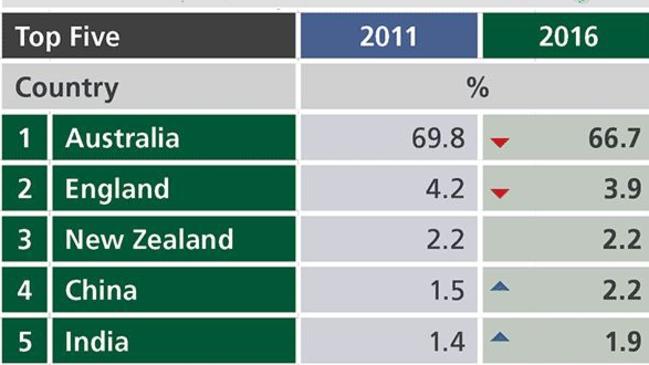Aussies more Asian than European, news census data reveals
SECOND generation Aussies will soon be a minority as census data reveals Australia has just reached a major tipping point.
AUSTRALIA is becoming more Asian than European, with Census 2016 data revealing little more than half of its residents — 50.7 per cent — have two Australian-born parents.
This is down from 54 per cent in the 2011 census and means second-generation Aussies will soon be a minority.
More than a quarter of our residents (26.3 per cent) are now born overseas, and for the first time in our history, the majority of people born abroad are from Asia, not Europe.
Just over 6,150,000 people were born overseas in census 2016, compared to 5,280,802 in 2011.
he 2016 Census shows that two thirds (67%) of the Australian population were born in Australia. Of the 6,163,667 overseas-born persons, nearly one in five (18 per cent) had arrived since the start of 2012.
While England and New Zealand were still the next most common countries of birth after Australia, the proportion of those born overseas who were born in China and India has increased since 2011 (from 6 per cent to 8.3 per cent and 5.6 per vent to 7.4 per cent respectively).
The Philippines has swapped places with Italy in the top 10 “country of birth” list, moving from number eight to number six.
Malaysia now appears in the top 10 countries of birth (replacing Scotland) and represents 0.6 per cent of the Australian population.
A breakdown of the country of birth includes 907,570 people from England, 518,466 from New Zealand 509,555 from China, 455,389 from India, and 232,386 from the Philippines.
More than one million new migrants have come to Australia since 2011, with China (191,000) and India (163,000) the most common countries of birth for new arrivals.
This is followed by migrants from the UK (8.3 per cent growth), New Zealand (7.4 per cent growth) and the Philippines (4.9 per cent growth). Cities have absorbed the bulk of the migrants, with most settling in Sydney and Melbourne.
Australia remains predominantly an English speaking country, with 72.7 per cent of people reporting they speak only English at home. But that is down from 76.8 per cent in 2011.
After English, the most common languages are Mandarin, Arabic, Cantonese and Vietnamese of the 300 languages being spoken in Australian homes.
Mandarin is spoken by 2.2 per cent of Australians, up from 1.6 per cent, and Arabic by 1.4 per, up from 1.3 per cent. Vietnamese and Cantonese are each spoken by another 1.2 per cent.
The 2016 census data reveals Australia’s population has doubled in the past 50 years, soaring by two million since 2011.
Australia’s estimated population at December 31 was 24.4 million.




